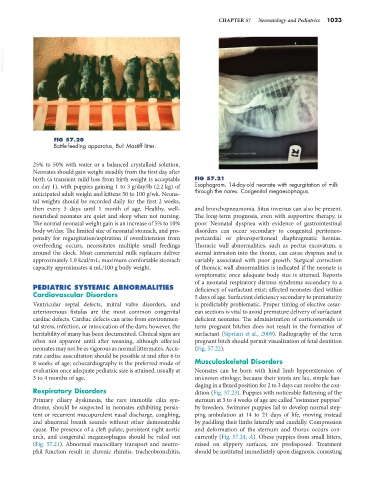Page 1051 - Small Animal Internal Medicine, 6th Edition
P. 1051
CHAPTER 57 Neonatology and Pediatrics 1023
VetBooks.ir
FIG 57.20
Bottle-feeding apparatus, Bull Mastiff litter.
25% to 50% with water or a balanced crystalloid solution.
Neonates should gain weight steadily from the first day after
birth (a transient mild loss from birth weight is acceptable FIG 57.21
on day 1), with puppies gaining 1 to 3 g/day/lb (2.2 kg) of Esophagram, 14-day-old neonate with regurgitation of milk
anticipated adult weight and kittens 50 to 100 g/wk. Neona- through the nares. Congenital megaesophagus.
tal weights should be recorded daily for the first 2 weeks,
then every 3 days until 1 month of age. Healthy, well- and bronchopneumonia. Situs inversus can also be present.
nourished neonates are quiet and sleep when not nursing. The long-term prognosis, even with supportive therapy, is
The normal neonatal weight gain is an increase of 5% to 10% poor. Neonatal dyspnea with evidence of gastrointestinal
body wt/day. The limited size of neonatal stomach, and pro- disorders can occur secondary to congenital peritoneo-
pensity for regurgitation/aspiration if overdistension from pericardial or pleuroperitoneal diaphragmatic hernias.
overfeeding occurs, necessitates multiple small feedings Thoracic wall abnormalities, such as pectus excavatum, a
around the clock. Most commercial milk replacers deliver sternal intrusion into the thorax, can cause dyspnea and is
approximately 1.0 kcal/mL; maximum comfortable stomach variably associated with poor growth. Surgical correction
capacity approximates 4 mL/100 g body weight. of thoracic wall abnormalities is indicated if the neonate is
symptomatic once adequate body size is attained. Reports
of a neonatal respiratory distress syndrome secondary to a
PEDIATRIC SYSTEMIC ABNORMALITIES deficiency of surfactant exist; affected neonates died within
Cardiovascular Disorders 5 days of age. Surfactant deficiency secondary to prematurity
Ventricular septal defects, mitral valve disorders, and is predictably problematic. Proper timing of elective cesar-
arteriovenous fistulas are the most common congenital ean sections is vital to avoid premature delivery of surfactant
cardiac defects. Cardiac defects can arise from environmen- deficient neonates. The administration of corticosteroids to
tal stress, infection, or intoxication of the dam; however, the term pregnant bitches does not result in the formation of
heritability of many has been documented. Clinical signs are surfactant (Sipriani et al., 2009). Radiography of the term
often not apparent until after weaning, although affected pregnant bitch should permit visualization of fetal dentition
neonates may not be as vigorous as normal littermates. Accu- (Fig. 57.22).
rate cardiac auscultation should be possible at and after 6 to
8 weeks of age; echocardiography is the preferred mode of Musculoskeletal Disorders
evaluation once adequate pediatric size is attained, usually at Neonates can be born with hind limb hyperextension of
3 to 4 months of age. unknown etiology; because their joints are lax, simple ban-
daging in a flexed position for 2 to 3 days can resolve the con-
Respiratory Disorders dition (Fig. 57.23). Puppies with noticeable flattening of the
Primary ciliary dyskinesia, the rare immotile cilia syn- sternum at 3 to 4 weeks of age are called “swimmer puppies”
drome, should be suspected in neonates exhibiting persis- by breeders. Swimmer puppies fail to develop normal step-
tent or recurrent mucopurulent nasal discharge, coughing, ping ambulation at 14 to 21 days of life, moving instead
and abnormal breath sounds without other demonstrable by paddling their limbs laterally and caudally. Compression
cause. The presence of a cleft palate, persistent right aortic and deformation of the sternum and thorax occurs con-
arch, and congenital megaesophagus should be ruled out currently (Fig. 57.24, A). Obese puppies from small litters,
(Fig. 57.21). Abnormal mucociliary transport and neutro- raised on slippery surfaces, are predisposed. Treatment
phil function result in chronic rhinitis, tracheobronchitis, should be instituted immediately upon diagnosis, consisting

